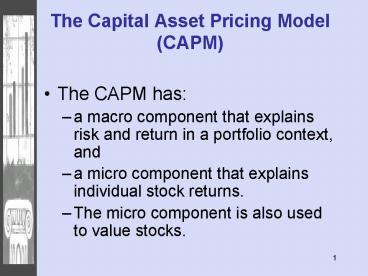The Capital Asset Pricing Model CAPM - PowerPoint PPT Presentation
1 / 24
Title:
The Capital Asset Pricing Model CAPM
Description:
Beta = 1.0 Stock's return has same volatility as the market return. ... Portfolio Betas. Weighted average of the individual asset's betas ... – PowerPoint PPT presentation
Number of Views:433
Avg rating:3.0/5.0
Title: The Capital Asset Pricing Model CAPM
1
The Capital Asset Pricing Model (CAPM)
- The CAPM has
- a macro component that explains risk and return
in a portfolio context, and - a micro component that explains individual stock
returns. - The micro component is also used to value stocks.
2
The Capital Market Line
- The capital market line
- adds a risk-free return, and
- redefines the efficient frontier.
3
The Capital Market Line
4
Risk and Return
- The investor continues to select the portfolio
that - offers the highest return for a given level of
risk, and - maximizes satisfaction.
- Different investors may select different
combinations of risk and return.
5
Risk and Return
- Different asset classes lie on the capital market
line
6
Beta Coefficients
- An index of risk
- Measures the volatility of a stock (or portfolio)
relative to the market
7
Beta Coefficients Combine
- The variability of the assets return
- The variability of the market return
- The correlation between
- the stock's return, and
- the market return.
8
Beta Coefficients
- Beta coefficients are the slope of the regression
line relating - the return on the market (the independent
variable) to - the return on the stock (the dependent variable)
9
Beta Coefficients
10
Interpretation of the Numerical Value of Beta
- Beta 1.0 Stock's return has same volatility as
the market return. - Beta gt 1.0 Stock's return is more volatile than
the market return.
11
Interpretation of the Numerical Value of Beta
12
Interpretation of the Numerical Value of Beta
- Beta lt 1.0 Stock's return is less volatile than
the market return.
13
Interpretation of the Numerical Value of Beta
14
High Beta Stocks
- More systematic market risk
- May be appropriate for high-risk tolerant
(aggressive) investors.
15
Low Beta Stocks
- Less systematic market risk
- May be appropriate for low-risk tolerant
(defensive) investors.
16
Individual Stock Betas
- May change over time
- Tendency to move toward 1.0, the market beta
17
Portfolio Betas
- Weighted average of the individual asset's betas
- May be more stable than individual stock betas
18
Beta Coefficients and The Security Market Line
- The return on a stock depends on
- the risk free rate (rf)
- the return on the market (rm)
- the stock's beta
- the return on a stockk rf (rm - rf)beta
19
Beta Coefficients and The Security Market Line
- The figure relating systematic risk (beta) and
the return on a stock
20
Beta Coefficients and The Security Market Line
21
Arbitrage Pricing Theory (APT)
- In the CAPM
- A stock's return depends only on
- the market return, and
- the volatility of the stock (the beta).
- APT is an alternative to the Capital Asset
Pricing Model.
22
Arbitrage
- Buying in one market and simultaneously selling
in another market to take advantage of price
differentials - Assures there can be only one price
- Assures that portfolios with the same risk will
have the same returns
23
APT explains security returns in terms of
- The expected return
- A series of factors that may affect security
prices - How the individual stock responds to
unanticipated changes in those factors
24
Common Factors
- Unexpected inflation
- Unexpected changes in industrial production
- Unanticipated shifts in risk premiums
- Unanticipated changes in the structure of yields































